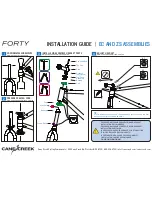
67
SEATPOST QUICK RELEASE
Many bikes are equipped with quick-release seatpost binders. While a quick release looks like a long bolt with a
lever on one end and a nut on the other, in fact the quick release uses a cam action to firmly clamp the seatpost.
Adjusting the Quick Release Mechanism
The action of the quick release cam squeezes the seat collar around the seatpost to hold the seatpost securely
in place. The amount of clamping force is controlled by the tension adjusting nut. Turning the tension adjusting
nut clockwise while keeping the cam lever from rotating increases clamping force; turning it counterclockwise
while keeping the cam lever from rotating reduces clamping force. Less than half a turn of the tension adjusting
nut can make the difference between safe clamping force and unsafe clamping force.
WARNING
Riding with an improperly tightened seatpost can allow the
saddle to turn or move and cause you to lose control and fall.
Therefore:
1.
Ask your local bicycle specialist to help you make sure you
know how to correctly clamp your seatpost.
2.
Understand and apply the correct technique for clamping your
seatpost quick release.
3.
Before you ride the bike, first check that the seatpost is
securely clamped.
CAUTION
The full force of the cam action is needed to
clamp the seatpost securely. Holding the nut with
one hand and turning the lever like a wing nut with
the other hand until everything is as tight as you
can get it will not clamp the seatpost safely.
CAUTION
If you can fully close the quick release without wrap-
ping your fingers around the seatpost for leverage,
and the lever does not leave a clear imprint in the
palm of your hand, the tension is insufficient. Open
the lever; turn the tension adjusting nut clockwise a
quarter turn; then try again.
HOW THINGS WORK
HOW THINGS WORK
|
Summary of Contents for MULTI-SPEED
Page 44: ...36 ASSEMBLY ASSEMBLY lbs ...
Page 66: ...58 ASSEMBLY ASSEMBLY ...















































